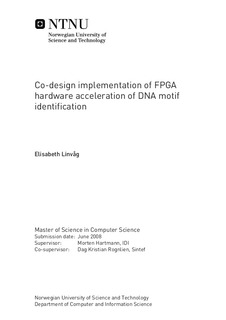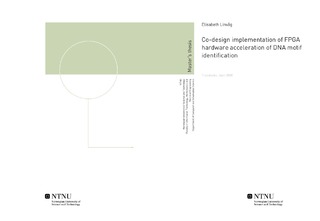| dc.description.abstract | Pattern matching in bio-informatics is a discipline in sturdy growth, and has a great need for searching through large amounts of data. At NTNU, a prototype specified in VHDL has been developed for an FPGA-solution identifying short motifs or patterns in genetic data using a Position-Weight Matrix (PWM). But programming FPGAs using VHDL is a complicated and time consuming process that requires intimate knowledge of how hardware works, and the prototype is not yet complete in terms of required functionality. Consequently, a desirable alternative is to make use of co-design languages to facilitate the use of hardware for a software developer, as well as to integrate the environment for development of soft- and hardware. This thesis deal with specification and implementation of a co-design based alternative to the existing VHDL based solution, as well as an evaluation of productivity vs final performance of the newly developed solution compared to the VHDL based solution. The chosen co-design language is Impulse-C, created by Impulse Accelerated Technologies Inc., which is a co-design language designed for data-flow oriented applications, but with the flexibility to support other programming models as well. The programming model simplifies the expression of highly parallel algorithms through the use of well-defined data communication, message passing and synchronization mechanisms. The affiliated development environment, CoDeveloper, contains tools that allow the FPGA system to be developed and debugged using Impulse-C. The software-to-hardware compiler and optimizer translates C-language processes to (RTL) VHDL code, while optimizing the generated logic and identifying opportunities for parallelism. Ease-of-use for the CoDeveloper environment is evaluated in this thesis, based on the authors experiences with the tools. In total, four variations of the Impulse-C solution has been implemented; a basic solution and a multicore solution, both implemented in a floating-point and a 'fixed-point' version. The implemented solutions are analyzed through various experiments described in this thesis, done during simulation using CoDeveloper. Attempts were made to get the solutions to run on the target platform, the Cray XD1 supercomputer Musculus, but these were unsuccessful. A wrong choice of properties and constraints in Xilinx ISE are believed to have caused the FPGA programming file to be generated faulty. There was no time to confirm and correct this. Some information about device utilization and performance could still be extracted from the Xilinx ISE 'Static timing' and 'Place and route' reports. | nb_NO |

